Visitors to the UConn Co-op Bookstore and the Ballard Institute and Museum of Puppetry (BIMP) will see a colorful new addition to their shared space in Storrs Center – a mural depicting a Chinese dragon puppet, a marionette, a traditional Punch hand puppet, floating musical notes, flying books, and the iconic figure of literary giant and Hartford resident Mark Twain.
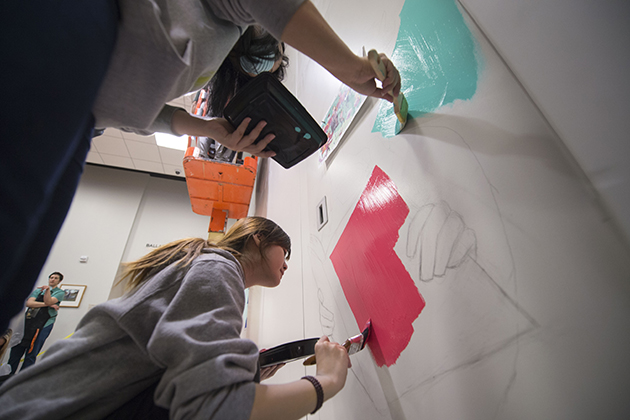
The mural, 22 feet long and more than 13 feet high, is on the folding wall that opens from the bookstore into the space that serves as a both a performance theater for puppet shows and a gathering place for authors to speak about their books. It was created by illustration students in classes taught this past year in the School of Fine Arts by Cora Lynn Deibler, professor of illustration, and Alison Paul, instructor in illustration and animation.
John Bell, director of the Ballard Institute, recalls discussing “the nature of the wall as a kind of meeting place of all the different things going on in our shared space – puppets, performance, literary history, books, literature, poetry, and music. The way I look at it, the wall is the threshold of where the bookstore and the Ballard Institute meet.”
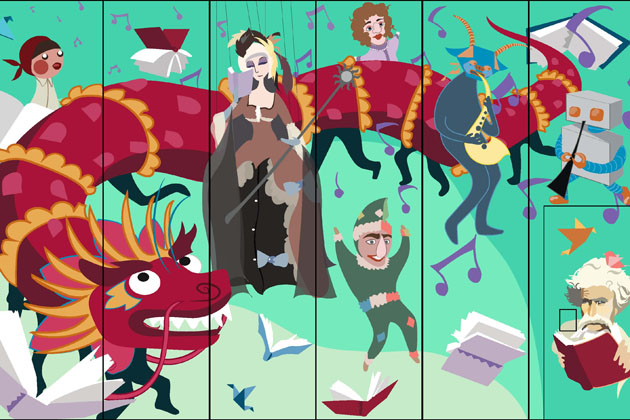
When the store was being built, the bookstore designers were asked to plan for a mural to be painted on the surface of the folding wall. Suzy Staubach, manager of the Co-op Bookstore, says the idea was to have a mural in the Storrs Center location much like the one created by Bonnie Rose (Sullivan) Wrigley ’07 (SFA) on a wall in the main Co-op on Hillside Road. She discussed with Paul the idea of having illustration students create the mural, and Deibler and Paul coordinated the project as an assignment in their fall classes.
Bell and Staubach selected the final mural design from six student proposals. The assignment was challenging in several ways – classes were divided into three creative teams of four artists who usually work independently; they were required to follow a template for a design to cover six large panels, including one with a door; and each group needed to develop one concept and present it in three different ways.
The design phase for the mural took place in the fall semester, and the painting of the mural was done in the spring semester. Ideas for the mural included a puppet theater stage with books at the bottom and puppets in the center, and a joyful scene of children and animals in a field reading books or playing with puppets.
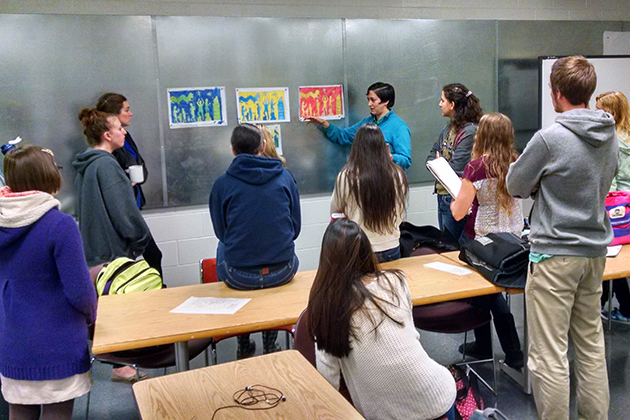
Last fall, as students gathered in the Bishop Center in front of a wall where the selected design was projected, Deibler praised the students whose work was chosen – Ian Brady ’15 (SFA), Michelle Hawran ’16 (SFA), Amanda Pokorny ’14 (SFA), and Natassje Unger ’15 (SFA) – and offered advice to further improve the design.
“I want to compliment you on pulling it together stylistically,” she said, “because before it did look like four people worked on it, which is what happened, but this looks like one artist. The books are much improved. I like the changes.”
Deibler suggested the students change the color on the scales of the dragon to add more contrast to the image; improve the shape of a musical note to make it more identifiable; and sharpen the lines on the faces of two puppet characters. She also noted that the book held by Mark Twain needed to move closer to the author’s image so it was almost entirely on the door that is on the last panel of the folding wall.
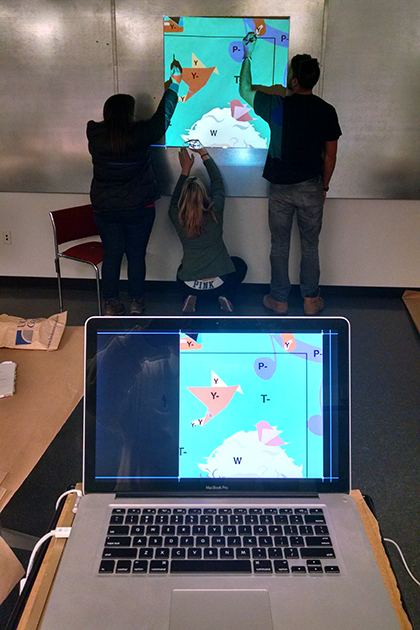
“Once it’s on the wall,” she added, “[the mural is] going to be there for a number of years. You want to be super proud of it. After you graduate, you don’t want to see that one thing you wished you had addressed. All of your decisions today are what [the students who paint it] will go by. It’s a lot of small things.”
Brady, one of the student designers, said it was hard having four different artists who all have their own style try to make a single cohesive piece. “When we were down to one style,” he said, “the project started to progress a lot smoother.”
Hawran, another of the student designers, said the toughest part was going all the way back to the beginning to successfully “marry” puppets and books. “Suzy was all about the books and John was all about the puppets. There’s a connection between books and puppets that you see but can’t quite put your finger on. It took us a few classes to figure out how to illustrate both.”
By early April, students in the two spring illustration classes began the final steps to paint the mural on the folding wall, guided by suggestions from Melica Bloom and Ben Keller of MBK Murals of Willimantic, who specialize in hand painting. After training on the safe use of the lift and ladder needed to reach the highest part of the wall, the students transferred the design to 3-foot square grid sections. Each section was projected from a laptop computer to the wall of the Bishop classroom, and a group of students traced the lines onto a piece of brown paper to create a stencil, a process known as pouncing.
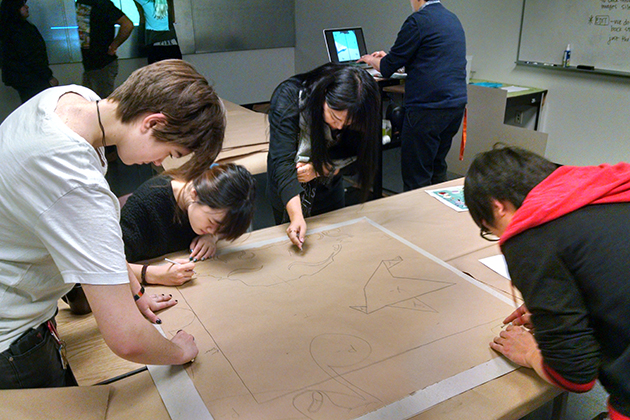
A second group of students used a small wheel with spikes to run over the lines on the paper and perforate the stencil, which was then handed to a third group of students, who flipped over the paper and sanded the back of the stencil to remove loose bits of paper left by the pouncing wheel.
Back in the Co-op Bookstore, the illustration students placed each grid section on its proper place on the folding wall, patting a fine blue powder, similar to that used on a carpenter’s chalk line, over the paper. Once the grid section was removed, students followed the blue line with a black graphite pencil to make the design visible to the eye. Color codes were also noted for each section of the grid to guide the final painting of the mural.
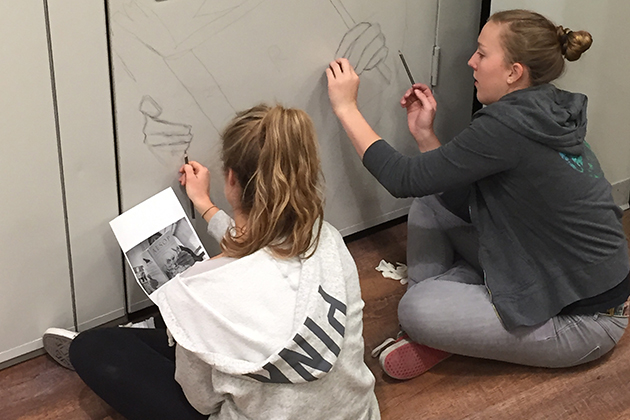
“When we had the students design these in the fall, they were told to think of it as a four- to six-color silkscreen,” explains Paul. “Professor Deibler and I broke all the shapes in the grids into colors with a code, using standard color codes for printing. They transferred the code to the wall after each stencil grid was taken down, kind of like a paint-by-number.”
While the two classes of students were working in mid-April on the lift and ladders painting the mural, visitors to the Bookstore and Le Petite Marche Café would see the activity in the far corner of the Co-op and walk over to spend a few moments watching the mural unfold.
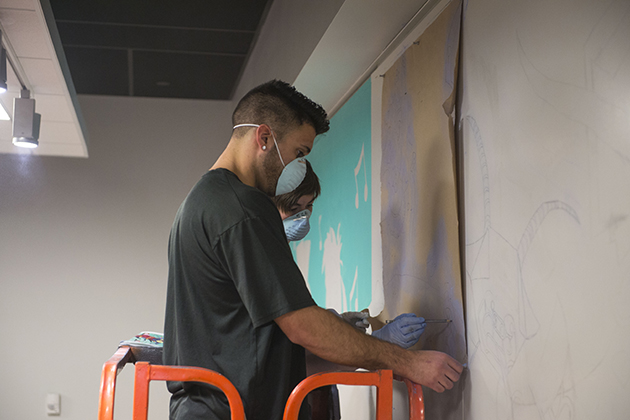
“It’s stopping people in their tracks,” Staubach says. “You can see if from the Café. It’s very exuberant. It’s such a happy piece of art. It puts you in a good mood. I’m thrilled.”



